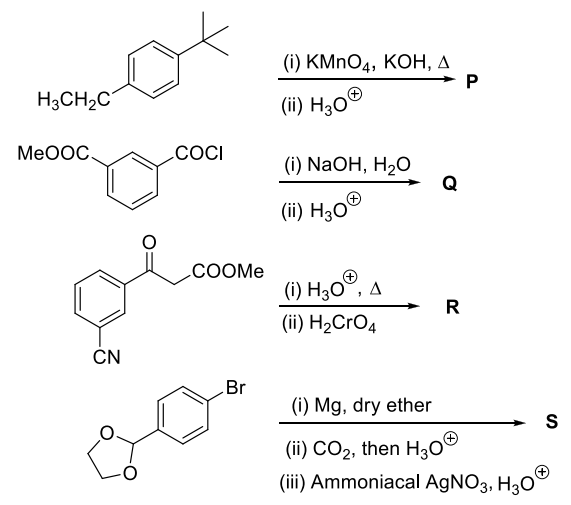For the same number of carbon atoms, three hydrocarbons P, Q and R have hydrogen in the ratio of 3: 2:1. Which of the following is incorrect about the reactions shown by P, Q and R?
P does not undergo addition reactions.
Both Q and R decolourise bromine water.
Both Q and R give white precipitate with AgNO3 solution dissolved in NH4OH.
None of these
The correct Answer is:C
To solve the question regarding the hydrocarbons P, Q, and R, we need to analyze their structures and the reactions they undergo based on the given hydrogen ratios.
1. Identify the Hydrocarbons:
- Given the ratio of hydrogen atoms in hydrocarbons P, Q, and R is 3:2:1, we can assign the following molecular formulas based on the same number of carbon atoms (let's assume 2 carbon atoms for simplicity):
- P (C2H6): Ethane
- Q (C2H4): Ethene
- R (C2H2): Ethyne
2. Determine the Type of Hydrocarbons:
- P (C2H6) is an alkane (single bonds).
- Q (C2H4) is an alkene (double bonds).
- R (C2H2) is an alkyne (triple bonds).
3. Analyze the Reactions:
- P (C2H6): As an alkane, it does not undergo addition reactions due to the absence of double or triple bonds.
- Q (C2H4): As an alkene, it can undergo addition reactions and will decolorize bromine water.
- R (C2H2): As an alkyne, it can also undergo addition reactions and will decolorize bromine water.
4. Evaluate the Statements:
- The statement "P is not undergoing an addition reaction" is true.
- The statement "Q and R decolorize bromine water" is true.
- The statement "Both Q and R give a white precipitate with AgNO3 solution dissolved in NH4OH" is false. Only alkynes (like R) can form a white precipitate with AgNO3.
5. Conclusion:
- The incorrect statement regarding the reactions shown by P, Q, and R is that both Q and R give a white precipitate with AgNO3 solution.
Final Answer:
The incorrect statement about the reactions shown by P, Q, and R is that both Q and R give a white precipitate with AgNO3 solution dissolved in NH4OH.
- Given the ratio of hydrogen atoms in hydrocarbons P, Q, and R is 3:2:1, we can assign the following molecular formulas based on the same number of carbon atoms (let's assume 2 carbon atoms for simplicity):
- P (C2H6): Ethane
- Q (C2H4): Ethene
- R (C2H2): Ethyne
- P (C2H6) is an alkane (single bonds).
- Q (C2H4) is an alkene (double bonds).
- R (C2H2) is an alkyne (triple bonds).
- P (C2H6): As an alkane, it does not undergo addition reactions due to the absence of double or triple bonds.
- Q (C2H4): As an alkene, it can undergo addition reactions and will decolorize bromine water.
- R (C2H2): As an alkyne, it can also undergo addition reactions and will decolorize bromine water.
- The statement "P is not undergoing an addition reaction" is true.
- The statement "Q and R decolorize bromine water" is true.
- The statement "Both Q and R give a white precipitate with AgNO3 solution dissolved in NH4OH" is false. Only alkynes (like R) can form a white precipitate with AgNO3.
- The incorrect statement regarding the reactions shown by P, Q, and R is that both Q and R give a white precipitate with AgNO3 solution.
The incorrect statement about the reactions shown by P, Q, and R is that both Q and R give a white precipitate with AgNO3 solution dissolved in NH4OH.
Topper's Solved these Questions
- CARBON AND ITS COMPOUNDSBook:SCIENCE OLYMPIAD FOUNDATION Chapter:CARBON AND ITS COMPOUNDSExercise:ACHIEVERS SECTION (HOTS)
Explore 5 Videos
- ACIDS, BASES AND SALTSBook:SCIENCE OLYMPIAD FOUNDATION Chapter:ACIDS, BASES AND SALTSExercise:ACHIEVERS SECTION (HOTS)
Explore 5 Videos
- CHEMICAL REACTIONS AND EQUATIONSBook:SCIENCE OLYMPIAD FOUNDATION Chapter:CHEMICAL REACTIONS AND EQUATIONSExercise:MULTIPLE CHOICE QUESTIONS
Explore 20 Videos
Similar Questions
Knowledge Check
For a reaction P+Q→2R+S. Which of the following statements is incorrect?
ARate of disappearance of P = Rate of appearance of SBRate of disappearance of Q = 2× Rate of appearance of RCRate of disappearance of P = Rate of disappearance of QDRate of disappearance of Q = 12× Rate of appearance of RThe mean of p, q, and r is same as the mean of q, 2r, and s. then which of the following is correct ?
Ap=q=rBq=r=sCq=rDp=r+sThe mean of p, q, and r is same as the mean of q, 2r, and s. then which of the following is correct ?
Ap = q = rBq = r = sCq=rDp=r+s
If p, q, r are prime numbers such that p2−q2=r then which of the following options are correct ?
View SolutionIn the following reactions, P, Q, R, and S are the major products.

The correct statement(s) about P, Q, R, and S is(are)
View SolutionIf there are three sum of money P,Q and R so that P is the simple interest of Q and Q is the simple interest of R, rate % and time are same in each case, then the relation of P, Q and R is given by
View SolutionRefer to the given Venn diagram showing three organisms P, Q and R.

Which of the following statements hold true regarding P, Q and R?
(i) Chlamydomonas is shown as R.
(ii) Yeast is shown as Q.
(iii) Euglena is shown as P.
(iv) Organisms R and P form symbiotic association called lichen.
View SolutionRead the given passage and answer the questions.
P, Q and R are three elements which undergo chemical reactions according to the following equations.
(i) P2O3+2Q→Q2O3+2P
(ii) 3RSO4+2Q→Q2(SO4)3+3R
(iii) 3RO+2P→P2O3+3R
The type of reaction is:
View Solution

